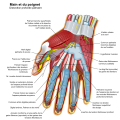File:Wrist and hand deeper palmar dissection-numbers.svg

Size of this PNG preview of this SVG file: 474 × 600 piksel. weerngooji: goɗɗi 190 × 240 piksel | 379 × 480 piksel | 607 × 768 piksel | 809 × 1 024 piksel | 1 619 × 2 048 piksel | 555 × 702 piksel.
Fiilde asliire (Fiilde SVG, werngo mum ko 555 × 702 pikelle, ɓetol fiildee: 207 KB)
Aslol fiilde
Dobo e ñalngu/waktu ngam yiyde fiilde ndee no nde yaltirta e oon waktu nih.
| Ñalngu/Waktu | Dooɓre | Ɓete | Kuutoro | Yowre | |
|---|---|---|---|---|---|
| gonaaɗo | 17:15, 1 Korse 2015 |  | 555 × 702 (207 KB) | Perhelion | optimize image |
| 11:42, 8 Morso 2012 |  | 555 × 702 (399 KB) | Wilfredor | optimize image | |
| 21:11, 13 Siilo 2009 |  | 555 × 702 (817 KB) | Wilfredor | {{Information |Description= |Source= |Date= |Author= |Permission= |other_versions= }} | |
| 16:37, 16 Yarkomaa 2008 |  | 555 × 702 (815 KB) | Wilfredor | {{Information |Description= |Source= |Date= |Author= |Permission= |other_versions= }} | |
| 19:33, 23 Morso 2008 |  | 770 × 767 (822 KB) | Bibi Saint-Pol | {{Created with Inkscape}} == {{int:filedesc}} == {{Information |Description= {{en|The hands (med./lat.: manus, pl. manūs) are the two intricate, prehensile, multi-fingered body parts normally located at the end of each arm of a human or other primate. Th |
Kuutorgol fiilde
Ngoo hello ena huutoroo ndee fiilde:
Kuutoragol fiilde kuuɓtidinngol
Wikiiji ɗii-ɗoo goɗɗi ena kuutoroo ndee fiilde:
- Kuutoragol e af.wikipedia.org
- Kuutoragol e ar.wikipedia.org
- Kuutoragol e az.wikipedia.org
- Kuutoragol e bew.wikipedia.org
- Kuutoragol e bjn.wikipedia.org
- Kuutoragol e bn.wikipedia.org
- Kuutoragol e br.wikipedia.org
- Kuutoragol e ce.wikipedia.org
- Kuutoragol e crh.wikipedia.org
- Kuutoragol e cv.wikipedia.org
- Kuutoragol e da.wikipedia.org
- Kuutoragol e de.wikipedia.org
- Kuutoragol e dtp.wikipedia.org
- Kuutoragol e en.wikipedia.org
- Wikipedia:Featured picture candidates/Wrist and hand deeper palmar dissection-en.svg
- Wikipedia:Featured picture candidates/April-2009
- User:Madhero88/Medicalg
- File talk:Wrist and hand deeper palmar dissection-numbers.svg
- Wikipedia:WikiProject Anatomy/Resources
- Wikipedia talk:WikiProject Anatomy/Archive 9
- User talk:Rhododendrites/Reconsidering FPC on the English Wikipedia
- Kuutoragol e es.wikipedia.org
- Kuutoragol e fa.wikipedia.org
- Kuutoragol e fr.wikipedia.org
- Kuutoragol e hr.wikipedia.org
- Kuutoragol e hu.wikipedia.org
- Kuutoragol e id.wikipedia.org
- Kuutoragol e incubator.wikimedia.org
- Kuutoragol e iu.wikipedia.org
- Kuutoragol e ko.wikipedia.org
- Kuutoragol e lbe.wikipedia.org
- Kuutoragol e lb.wikipedia.org
- Kuutoragol e lt.wikipedia.org
- Kuutoragol e ms.wikipedia.org
- Kuutoragol e nia.wiktionary.org
- Kuutoragol e os.wikipedia.org
- Kuutoragol e pl.wikipedia.org
- Kuutoragol e pt.wikipedia.org
Yiy jokkol kuutoragol kuuɓtidingol ngoo hello.






